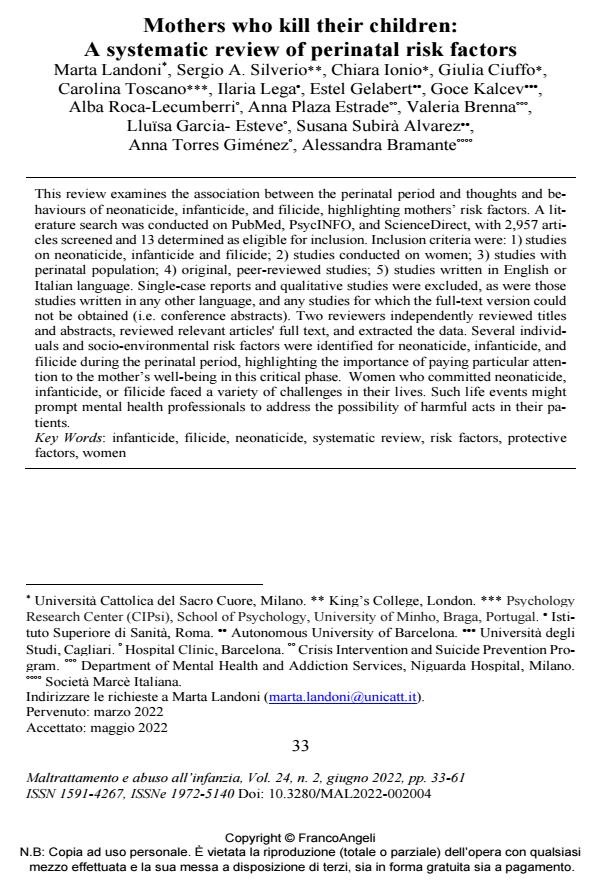Mothers who kill their children: A systematic review of perinatal risk factors
Journal title MALTRATTAMENTO E ABUSO ALL’INFANZIA
Author/s Marta Landoni, Sergio A. Silverio, Chiara Ionio, Giulia Ciuffo, Carolina Toscano, Ilaria Lega, Estel Gelabert, Goce Kalcev, Alba Roca-Lecumberri, Anna Plaza Estrade, Valeria Brenna, Lluïsa Garcia- Esteve, Susana Subirà Alvarez, Anna Torres Giménez, Alessandra Bramante
Publishing Year 2022 Issue 2022/2
Language English Pages 29 P. 33-61 File size 315 KB
DOI 10.3280/MAL2022-002004
DOI is like a bar code for intellectual property: to have more infomation
click here
Below, you can see the article first page
If you want to buy this article in PDF format, you can do it, following the instructions to buy download credits

FrancoAngeli is member of Publishers International Linking Association, Inc (PILA), a not-for-profit association which run the CrossRef service enabling links to and from online scholarly content.
This review examines the association between the perinatal period and thoughts and behaviours of neonaticide, infanticide, and filicide, highlighting mothers’ risk factors. A literature search was conducted on PubMed, PsycINFO, and ScienceDirect, with 2,957 articles screened and 13 determined as eligible for inclusion. Inclusion criteria were: 1) studies on neonaticide, infanticide and filicide; 2) studies conducted on women; 3) studies with perinatal population; 4) original, peer-reviewed studies; 5) studies written in English or Italian language. Single-case reports and qualitative studies were excluded, as were those studies written in any other language, and any studies for which the full-text version could not be obtained (i.e. conference abstracts). Two reviewers independently reviewed titles and abstracts, reviewed relevant articles' full text, and extracted the data. Several individuals and socio-environmental risk factors were identified for neonaticide, infanticide, and filicide during the perinatal period, highlighting the importance of paying particular attention to the mother’s well-being in this critical phase. Women who committed neonaticide, infanticide, or filicide faced a variety of challenges in their lives. Such life events might prompt mental health professionals to address the possibility of harmful acts in their patients.
Keywords: infanticide, filicide, neonaticide, systematic review, risk factors, protective factors, women
- Current policy and practice for the identification, management, and treatment of postpartum anxiety in the United Kingdom: a focus group study Elizabeth J. Harris, Semra Worrall, Victoria Fallon, Sergio A. Silverio, in BMC Psychiatry 680/2024
DOI: 10.1186/s12888-024-06058-7 - Understanding Filicide Risk: A Scoping Review to Inform Mental Health Nursing Practice Claire Hayes, Alison Hansen, Louise Alexander, in International Journal of Mental Health Nursing e70155/2025
DOI: 10.1111/inm.70155 - A systematic review of clinical psychological guidance for perinatal mental health Jayne O’Brien, Lynsey Gregg, Anja Wittkowski, in BMC Psychiatry 790/2023
DOI: 10.1186/s12888-023-05173-1
Marta Landoni, Sergio A. Silverio, Chiara Ionio, Giulia Ciuffo, Carolina Toscano, Ilaria Lega, Estel Gelabert, Goce Kalcev, Alba Roca-Lecumberri, Anna Plaza Estrade, Valeria Brenna, Lluïsa Garcia- Esteve, Susana Subirà Alvarez, Anna Torres Giménez, Alessandra Bramante, Mothers who kill their children: A systematic review of perinatal risk factors in "MALTRATTAMENTO E ABUSO ALL’INFANZIA" 2/2022, pp 33-61, DOI: 10.3280/MAL2022-002004